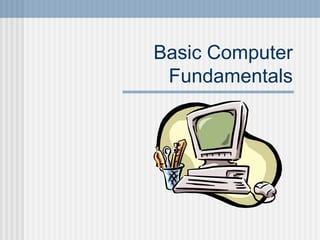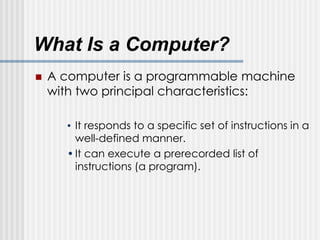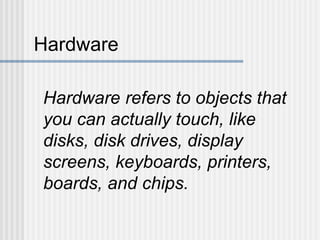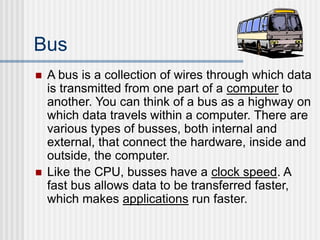Basic computer fundamentals
- 2. What Is a Computer? A computer is a programmable machine with two principal characteristics: • It responds to a specific set of instructions in a well-defined manner. •It can execute a prerecorded list of instructions (a program).
- 3. Modern Computers Are Electronic and Digital. They Can Be Described in Terms Their Hardware and Software. THE MODERN COMPUTER
- 4. Hardware Hardware refers to objects that you can actually touch, like disks, disk drives, display screens, keyboards, printers, boards, and chips.
- 7. K E Y B O S A R D
- 8. PRINTERS
- 9. CHIPS
- 10. USB TO MIDI
- 11. EXTERNAL STORAGE
- 12. USB HUB
- 13. Software Software exists as ideas, concepts, and symbols, but it has no substance.
- 14. Books provide a useful analogy. The pages and the ink are the hardware, while the words, sentences, paragraphs, and the overall meaning are the software. A computer without software is like a book full of blank pages -- you need software to make the computer useful just as you need words to make a book meaningful.
- 15. Computers Use Random Access Technology - Data Can Be Accessed in Any Order at Any Time Regardless of Storage Position or Time of Creation.
- 17. The Language of Computers Binary: the digital language of computers. This language is composed of an alphabet containing only 2 “letters” known as bits. Any work done on a modern computer from word processing to digital audio is translated to this language.
- 18. Digital Letters and Words Bit: the smallest form of information in the language of computers. It is represented as a zero or a one. A bit can be considered a letter in the digital language of binary. Byte: a “word” of information in binary. It is made of a number bits determined by the bit rate. 8 bits is usually = 1 byte on modern computers.
- 19. Bit Rate Bit rate: the number of “letters” or bits in a digital word or byte. An example of a 16 bit digital word in binary could be (01010101 10101010).
- 20. Example 8 bits = 1 byte 1024 bytes = 1 kilobyte (210) 1024 kilobytes = 1 megabyte (220) 1024 megabytes = 1 gigabyte (230)
- 21. Important Hardware CPU - abbreviation of central processing unit, the CPU is the brains of the computer. Sometimes referred to simply as the processor or central processor, the CPU is where most calculations take place. In terms of computing power, the CPU is the most important element of a computer system.
- 22. Clock Speed Clock speed - also called clock rate, the speed at which a microprocessor executes instructions. Every computer contains an internal clock that regulates the rate at which instructions are executed and synchronizes all the various computer components. The faster the clock, the more instructions the CPU can execute per second.
- 23. Bus A bus is a collection of wires through which data is transmitted from one part of a computer to another. You can think of a bus as a highway on which data travels within a computer. There are various types of busses, both internal and external, that connect the hardware, inside and outside, the computer. Like the CPU, busses have a clock speed. A fast bus allows data to be transferred faster, which makes applications run faster.
- 24. HARD DISK (Storage Device) The hard disk is a magnetic disk on which you can store computer data. The term hard is used to distinguish it from a soft, or floppy, disk. Hard disks hold more data and are faster than floppy disks. A hard disk, for example, can store anywhere from 10 to more than 100 gigabytes, whereas most floppies have a maximum storage capacity of 1.4 megabytes.
- 25. RAM Vs. ROM (Memory) Is an acronym for random access memory, a type of computer memory that can be accessed randomly; That is, any byte of memory can be accessed without touching the preceding bytes. RAM is the most common type of memory found in computers and other devices, such as printers.
- 26. RAM Vs. Rom In common usage, the term RAM is synonymous with main memory, the memory available to programs. For example, a computer with 300M RAM has approximately 2400 million bytes of memory that programs can use. In contrast, ROM (read-only memory) refers to special memory used to store programs that boot the computer and perform diagnostics. In fact, both types of memory (ROM and RAM) allow random access. To be precise, therefore, RAM should be referred to as read/write RAM and ROM as read-only RAM.
- 27. Important Software The operating system software is the most important program that runs on a computer. Every general-purpose computer must have an operating system to run other programs.
- 28. Peripherals Operating systems perform basic tasks, such as recognizing input from the keyboard, sending output to the display screen, keeping track of files and directories on the disk, and controlling peripheral devices.
- 30. Applications Operating systems provide a software platform on top of which other programs, called application programs, can run. The application programs must be written to run on top of a particular operating system. Your choice of operating system, therefore, determines to a great extent the applications you can run.
- 31. Connectivity USB Short for universal serial bus, is an external bus standard that supports data transfer rates of 12 mbps (megabits per second). A single USB port can be used to connect up to 127 peripheral devices, such as mice, modems, and keyboards.
- 32. USB CABLES
- 33. Plug and Play USB also supports Plug-and-Play installation and hot plugging. Also referred to as Hi-Speed USB, USB 2.0 is an external bus that supports data rates up to 480 Mbps. USB 2.0 is an extension of USB 1.1. USB 2.0 is fully compatible with USB 1.1 and uses the same cables and connectors. (Two of the contacts carry data — one for each direction; the other two supply 5 VDC and a ground. Standard MIDI cables carry information in only one direction on a single data wire.)
- 34. A very fast external bus standard that supports data transfer rates of up to 400Mbps (in 1394a) and 800Mbps (in 1394b). Products supporting the 1394 standard go under different names, depending on the company. Apple, which originally developed the technology, uses the trademarked name FireWire. Other companies use other names, such as i.link and Lynx, to describe their 1394 products. FIREWIRE
- 35. More Fire A single 1394 port can be used to connect up 63 external devices. In addition to its high speed, 1394 also supports isochronous data -- delivering data at a guaranteed rate. This makes it ideal for devices that need to transfer high levels of data in real-time, such as video devices. Like USB, 1394 supports both plug- and-play and hot plugging, and also provides power to peripheral devices.
- 36. Even More Like USB, FireWire lets you hook things up to a computer. Unlike USB, however, FireWire will run quite happily without a computer. That makes it ideal for situations in which a computer would be unnecessary, such as in permanent audio installations like theaters or churches. It also gives FireWire another advantage, because devices can talk directly to each other without having to go through a computer's operating system.
- 37. The Mac Lab: Computer And Peripherals Digidesign Mbox Korg X5D Iomega 250 Mb zip drive Midi to USB interface USB hub Keyboard / mouse
- 38. Digidesign Mbox USB digital interface for ProTools software allows: • Analog to digital conversion by way of microphone, line and instrument inputs • Digital to analog conversion to headphone and line outputs • Digital transmission by way of SPDIF (Sony Phillips digital interface) input/output
- 39. Korg X5D Digital synthesizer
- 40. Iomega 250 Mb Zip Drive External Storage Device
- 41. Midi to USB Interface Converts midi messages to USB
- 42. USB Hub Provides multiple ports
- 43. Keyboard / Mouse USB data entry devices
- 44. THE MAC LAB SET UP COLOR CODE for diagram: BLUE – USB GREEN – MIDI RED – AUDIO
- 45. USB AUDIOMIDI
- 46. YUP THAT’S IT!














































